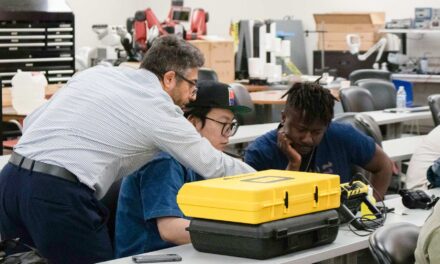
Engineering education PEERSISTence
Assistant Professor Ryan Milcarek leads National Science Foundation-funded program to improve engineering education for transfer students

Arizona State University’s charter states, “ASU is a comprehensive public research university, measured not by whom it excludes, but by whom it includes and how they succeed.” When hearing university President Michael Crow champion this message during his first weeks as an assistant professor of mechanical and aerospace engineering in the Ira A. Fulton Schools of Engineering, Ryan Milcarek knew he was in good company.
In pursuit of this educational excellence, Milcarek is leading a $200,000 National Science Foundation-funded Professional Formation of Engineers: Research Initiation in Engineering Formation, or PFE:RIEF, project. The project aims to help transfer students, who are disproportionately first-generation college students and students from historically underrepresented groups, succeed in their engineering studies.
The project aims to evaluate the performance of peer-led study groups in an introduction to thermodynamics course. Milcarek has been leading a group of faculty instructors in experimenting with the method since Fall 2020. So far, the project has had anecdotal success in improving the number of students who pass the class.
“Michael Crow said that we are going to continue to accept all types of students; we’re going to help them in their pursuit of an education and help them to have a better life,” Milcarek says. “That resonated with me. It’s just been a pretty natural fit.”
As a faculty member in the School for Engineering of Matter, Transport and Energy, part of the Fulton Schools, Milcarek fulfilled his long-standing dream to be an educator. His interest in improving engineering education has been growing since his days as engineering student. During his doctoral degree program at Syracuse University, Milcarek attended various engineering education conferences that furthered his fascination.
After some experience as an educator, he noticed students struggling in one particular course: thermodynamics.
“The thing with thermodynamics is that some students really get it, and it comes naturally to them,” he says. “For other students, they’re really smart students who have never struggled in a class before. When they take this class, they begin to question their ability because it’s so conceptually different from many of the classes they’ve taken.”
For many students transferring from community colleges, thermodynamics is often the first engineering course they take upon transferring to ASU.
Though students can transfer credits from community colleges, their GPAs do not transfer. To fail a class in the first semester after transferring can be devastating.
“If a transfer student does poorly in this class and in their other first semester courses, they may find themselves on academic probation,” Milcarek says. “You’re out of the program, pretty much.”
He determined that transfer students fail the class at a similar rate to other students, but when they do fail, they are about twice as likely to leave the engineering program.
Reflecting upon his experience taking classes, and with the guidance of engineering education experts like Gary Lichtenstein, Milcarek decided to try a different way of supporting his students: a peer-led study group model piloted by Uri Treisman at the University of California, Berkeley during the 1970s.
Trying the Treisman model
Traditionally, most undergraduate thermodynamics courses have a one-hour recitation every week taught by a teaching assistant. Recitation sessions are smaller classes designed to give focused help on major points from an associated lecture class.
“Essentially, we’re trying to change the way that one hour is taught,” Milcarek says. “Instead of having a teaching assistant lead that discussion, we are using the Treisman model to help these peer-led study groups form.”
The Treisman model, which has been implemented in several U.S. universities, presents students with challenging problems. In the process of solving the problems, students learn to think as experts do. To prevent students from getting stuck or too far off track, a student who recently passed the course is trained to offer effective guidance while not derailing the peer-led discovery process. Students can communicate more freely about concepts they are struggling with and relate to each other.
When Milcarek first noticed his students struggling with thermodynamics, he offered them an opportunity to join a peer-led study group. The first semester, four students volunteered. Three of the four students who attended the study group passed the class — a success rate that left Milcarek hopeful that this change of methodology would lead to success for his students.
The following semester, 30 students joined the group. The interest continued building until Milcarek had hundreds of students from multiple course sections participating.
To empirically assess the benefits of the approach, Milcarek sought the assistance of Gary Lichtenstein, founder of Quality Evaluation Designs; Karl Smith, a professor of engineering at Purdue University; and Samantha Brunhaver, an assistant professor of engineering at The Polytechnic School, part of the Fulton Schools. Each serves as a co-principal investigator or senior personnel on Milcarek’s NSF grant and mentor in the field of engineering education.
Engineering graduate students Cody Jenkins and Thien Ta have assisted with implementation and data analysis.
The team also benefits from the experience and support of Tami Coronella, the director of Student Success and Engagement in the Fulton Schools, and senior personnel on the NSF grant.
Building confidence and identity
While many other engineering education studies are focused on results in the form of academic success, this study will assess results based on another metric: students’ self-efficacy and disciplinary identity within engineering. Self-efficacy refers to a student’s confidence in their ability to take on engineering challenges. Disciplinary identity can be described as a student’s likelihood of self-identifying as an engineer. Both metrics can be more challenging to assess than grades but are at least as critical to students’ long-term persistence and success within the discipline.
“Whereas many students have an introductory, design-based experience in their first year to help ease them into these mezzanine-level courses, transfer students often don’t, which can contribute to ‘transfer shock’ and, ultimately, impact their engineering identity and persistence,” Brunhaver says.
Cody Jenkins is a mechanical engineering doctoral student who has helped lead study group sessions for almost three years. His involvement in the project began as an undergraduate teaching assistant for Milcarek’s thermodynamics course.
As a transfer student, Jenkins recognizes that a program like this would have helped him build community and confidence. He has seen the study groups improve the way students identify firsthand.
“One student began all her sentences with ‘I might be stupid but’ whenever she would suggest how to solve a problem for the first two sessions of the study group,” Jenkins says. “After the second session, I never heard her say that phrase again.”
Because feelings of disciplinary identity and self-efficacy are not as easily quantified as academic success, the researchers will have to employ methods from a variety of disciplines, including social science. The study will use interviews, surveys and student course data to get a full picture of students’ success.
As a first-generation college graduate himself, Milcarek sees himself in many of his transfer students. He says they often don’t develop the same sense of community among their peers as traditional students.
“By working through problems with peers, the course gives them social support, a network and helps them build confidence, which they may not otherwise easily develop in their first semester,” Milcarek says.
He believes that it is this social support and confidence that ensure a student’s persistence in an engineering discipline.
“It’s a pilot in the sense that we want to prove fundamentally whether this is working,” Milcarek says. “And if it is, we think we can change the way recitations are taught at ASU and then impact engineering curricula across the United States.”


































